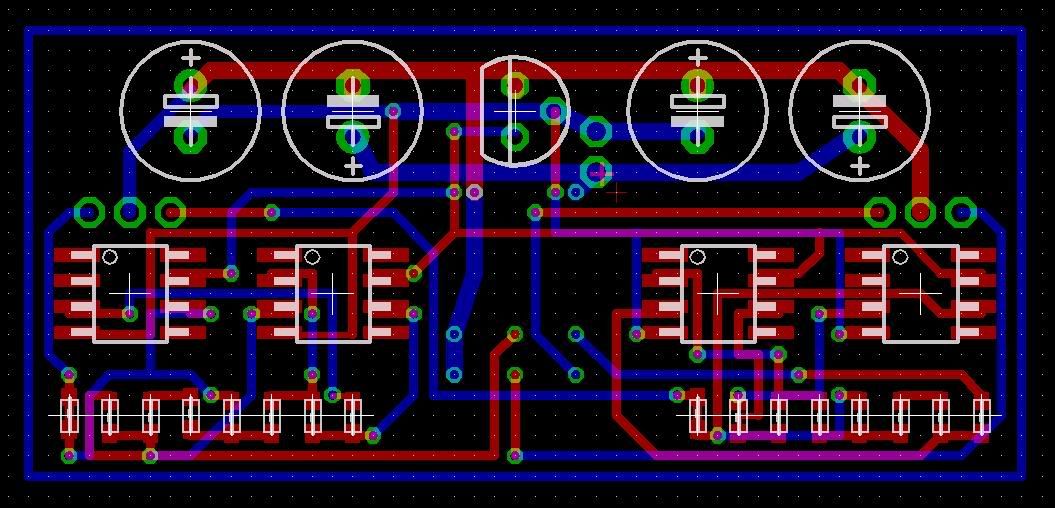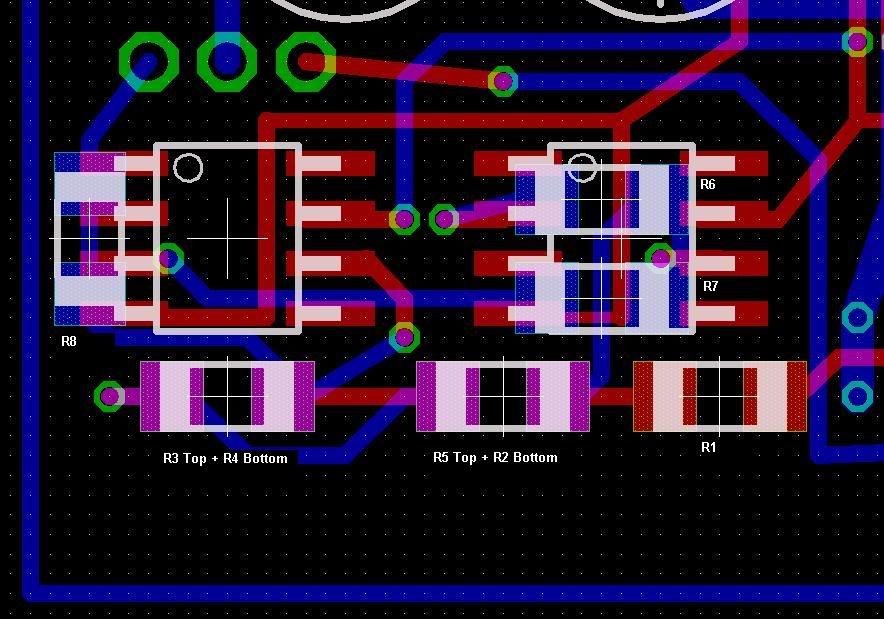Jazper: That looks simple enough, I will just add holes for some small film caps to parallel R4, as stated by Tangent on his
"Working with Cranky Op-Amps" page. Probably put spacing for the nice WIMA MKS-2 5mm caps on to parallel R4.
DaKi][er: As cire said, no autorouter was used, and I do believe we will step up to 1206 smd resistors all around, get some of those nice Vishay's. I had been contemplating changing the resistor layout before (and changed R8L as you can see), so I think we will go ahead and do that, hopefully tomorrow, as I have class until 10:30 tonight. We had been planning on bypassing the opamps, rail-ground, and while we hadnt thought about doing the same for the buffers, there is no reason not to, ceramics are cheap. I dunno if a ground plane is in this amp's future though, as we are most likely to put most of the resistors on the back of the board. Maybe a groundplane in all areas except for the resistor network?
Guzzler: Makes sense about the layout making a difference, especially in opamp stability. Good point about soldering the 0603 resistors, but I probably would tin the pads first, then reflow holding the resistor on with tweezers. As we now plan to go to 1206, it is kinda a moot point. We will remove as many vias as are viable, but there will definitly have to be some, if for no other reason than because there will be resistors on the back of the board. Are there any points in the amp that it is more important not to have vias?
Sinbios: I think we will stick with 2 single channel opamps, we are using SO8 opamps, so the use of a brown dog adapter isnt really possible, and we cant have too much vertical height in front of the caps, because of the I/O jacks. Also, you can buy most (all?) of the popular opamps in single channel configuration, but there are several (OPA627) that are not made as dual channel opamps.
Edwood: No, not really that much smaller footprint than a split mint, but it is only one board, and the layout is different. A split mint doesnt fit across the front of the smallest Hammond 1455, believe me, I have tried. Once we put the resistors on the back, we will save a little more space, but I dont really expect this to be a smaller board than the split mint. The people here made several good points that the layout is everything, and I cant imagine the additional wiring needed to let people use a dual opamp in this configuration would be good. If you really wanted though, it would be possible to cut all the traces from the opamp on either side, so the pads are isolated from the rest of the board, and air wire it to allow what you want. Wouldnt be pretty, efficient, or easy, and likely wouldnt sound as good, but it is possible.
Skyscraper: Not really any space to move further north, we could get a little, but as there is plenty of room on the back, I think we will just do that.
Glassman: That makes a good deal of sense, I never thought of that, or knew it was possible. I will give it a shot, see what we come up with.
Dougigs: I think we would have to extend the length of the PCB to do that, so would probably have to move up from the 80mm Hammond to 90mm or so. That said, we might try it, but not right now, maybe after we get this working. Also, I only have 2 BUF634U's here, and all the places I know of are out of stock. Maybe they will have more when we are ready to try adding a buffered ground. Maybe if I can find a supply of buffers I will try it, or I might just modify the layout for a buffered ground and post it here for anyone interested (and has buffers) to build.
I would have to look, it may be possible to stuff the third buffer on the back of the pcb, along with the resistors.
A lot of comments, keep them coming, I hope to have a revision up before the end of the week. I am kinda suprised there were no comments about our choice in using 4 electrolytic caps for the psu instead of 2 like Tangent's mint uses, or the complete lack of input caps, led pads, or other stuff. Also, if anyone knows of a battery holder for 8xAAA that fits in the back of the smallest hammond 1455 case, that would be very useful, as right now, I will probably have to do a custom setup that will not be nearly as nice. If we step up to the next length case, we could probably stuff a LM317 based recharging circuit and DC power jack into the amp, and maybe we could fit it, if we made the battery pack as compact as possible, although probably difficult to remove, in the current size.
 .
.






